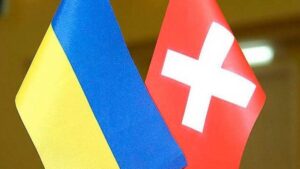
First Vice Prime Minister and Minister of Economy of Ukraine Yulia Svyrydenko and Ambassador Jacques Gerber, delegate of the Swiss Federal Council for Ukraine, signed an agreement amending the memorandum of understanding between the Ministry of Economy of Ukraine and the Swiss State Secretariat for Economic Affairs (SECO), which provides for a doubling of funding for recovery projects in Ukraine to CHF100 million.
As the press service of the Ministry of Economy reported on Tuesday, the document formalizes the decision of the Swiss Confederation to increase support for the competition for projects to restore Ukraine. The competition is open to Swiss companies that are already operating in Ukraine and can help in its recovery.
According to both sides, the interest of businesses was so high that they decided to double the funding at once.
“The high interest from Swiss business is a clear signal that our intergovernmental agreements are working. The additional CHF50 million will be allocated to projects in the areas of civilian protection, infrastructure restoration and development of the public utilities sector, as well as the modernization of public services. We are particularly interested in developing cooperation in the fields of energy, transport, housing, water supply, healthcare, industrial engineering, and education,” the press service quoted Svyrydenko as saying.
It is noted that the signed agreement opens up new opportunities for the implementation of joint projects under the intergovernmental initiative, which was launched in early 2025. The allocated funds are part of a broader CHF1.5 billion assistance program for Ukraine from Switzerland for 2025-2028. In total, Switzerland plans to invest CHF5 billion in a 12-year support program.
According to Jacques Gerber, the decision to increase funding is the result of close and trusting cooperation between Ukraine and Switzerland.
“Last week I visited Chernihiv, and last year I saw the scale of destruction in Kharkiv. Ukraine’s needs for recovery and reconstruction are enormous. At the same time, Swiss companies continue to operate in Ukraine despite all the challenges. They create jobs and pay taxes to the state budget of Ukraine. They also want to contribute to the country’s recovery,” Gerber explained.
The Ministry of Economy recalled that a memorandum of understanding between the Ministry and SECO on the implementation of a competition for projects for the economic recovery and reconstruction of Ukraine in cooperation with Swiss companies was signed on January 23, 2025, during the World Economic Forum in Davos.
The Ministry of Economy added that Switzerland is one of Ukraine’s key partners in the construction process. In April 2014, the Swiss government announced a program of long-term support for Ukraine totaling 5 billion francs for 12 years.

In January-March this year, Ukraine increased imports of aluminum ore and concentrate (bauxite) in physical terms compared to the same period last year – up to 8.219 thousand tons from 123 tons.
According to statistics released by the State Customs Service (SCS) on Tuesday, bauxite imports in monetary terms increased 8.6 times during this period, to $891 thousand from $104 thousand.
At the same time, imports were carried out mainly from Turkey (81.37% of supplies in monetary terms) and China (18.63%).
Ukraine did not re-export bauxite in 2025, as well as in 2024 and 2023.
As reported, in 2024, Ukraine increased imports of bauxite in physical terms by 77.4% compared to the previous year – up to 35.173 thousand tons, in monetary terms – by 74% – up to $4.107 million. Imports were carried out mainly from Turkey (78.48% of supplies in monetary terms), China (19.48%) and Spain (1.9%).
In 2023, Ukraine imported 19,830 thousand tons of bauxite for $2.360 million.
In 2022, Ukraine reduced imports of aluminum ore and concentrate (bauxite) in physical terms by 81.5% year-on-year to 945,396 thousand tons. Imports of bauxite in monetary terms decreased by 79.6% to $48.166 million. Imports were mainly from Guinea (58.90% of supplies in monetary terms), Brazil (27.19%) and Ghana (7.48%).
Bauxite is an aluminum ore that is used as a raw material to produce alumina, which is used to make aluminum. They are also used as fluxes in ferrous metallurgy.
Mykolaiv Alumina Plant (MAP) imports bauxite to Ukraine.

The eldest son of US President Donald Trump, Donald Trump Jr. is planning a tour of Eastern Europe, including visits to Serbia, Romania, the Czech Republic, Slovakia, Hungary and Bulgaria. This was reported by the Romanian portal G4Media.ro, citing sources close to the organizers of the events. The visit to Bucharest is scheduled for April 28, a week before the first round of the presidential election in Romania. Trump Jr. is expected to participate in the Trump Business Vision 2025 business event.
This visit comes shortly after his previous trip to Serbia in March 2025, when he met with President Aleksandar Vucic in Belgrade. During that meeting, they discussed strengthening bilateral relations between Serbia and the United States. According to Open4Business, one of the key goals of the last trip was to assess the potential for the construction of Trump Tower Belgrade, an ambitious real estate project focused on the premium segment. The project is financed by the firm of Trump’s son-in-law, Jared Kushner, and has caused controversy among the Serbian public.
Earlier, in December 2024, Trump Jr. criticized the cancellation of the elections in Romania, calling the decision of the Constitutional Court “an attempt by Soros the Marxist to rig the results and deny the will of the people.” His upcoming visit to the region may be linked to supporting certain political forces and promoting the Trump family’s business interests.
Source: https://t.me/relocationrs/783

Exports of Ukrainian chicken eggs in January-March 2025 amounted to 496 million units, which is twice as much as in the same period last year, the Union of Poultry Breeders of Ukraine (UBU) reported.
“The doubling of exports in the first three months of the year, compared to January-March 2024, did not negatively affect the supply of eggs on the domestic market. Traditionally, on the eve of Easter, the demand for eggs increases, but this year, as in the past, no shortage of products is expected and consumers will be able to count on affordable price offers in sufficient quantities during the Easter holidays,” the association noted.
The industry association emphasized that in 2025 there were significant changes in the geography of exports. The share of EU countries increased to 72%, but this growth is only 3% compared to the same period in 2024.
Deliveries to African countries increased, where the global environment offered quite favorable conditions for trade. The share of the African continent increased to 8%, while last year it was 5%, and in 2023, no eggs were exported at all during this period.
In 2025, Ukraine began supplying eggs to the UK, with a share of 7%. On the other hand, Singapore’s share in the regional export structure decreased from 15% in 2023 to 4% in 2025.
Deliveries to Israel are stable, although the share has decreased to 9%, but the physical volume of exports has not changed compared to January-March 2024.
Exports to the Middle East are almost non-existent due to logistical issues and high competition in the region from other exporting countries.
“The European market will continue to be a priority for exports due to convenient logistics and high demand for Ukrainian products. Until recently, only 4 companies had the right to export to the EU, and today there are already 15. In the future, Ukrainian exporters will maintain strong positions in the EU markets, offering safe and high-quality products,” the Union of Poultry Breeders of Ukraine summarized.
As reported earlier, the Antimonopoly Committee of Ukraine (AMCU) has issued binding recommendations to the ten largest producers and sellers of chicken eggs to prevent violations of the legislation on protection of economic competition.

In January-March this year, Ukrainian mining companies reduced exports of iron ore by 5.7% in physical terms compared to the same period last year, to 8 million 492.479 thousand tons.
According to the statistics released by the State Customs Service on Tuesday, foreign exchange earnings from iron ore exports decreased by 20.3% to $687.788 million during this period.
Exports of iron ore were carried out mainly to China (46.46% of supplies in monetary terms), Poland (16.05%) and Slovakia (16.14%).
In January-March 2025, Ukraine imported iron ore worth $24 thousand in the amount of 43 tons from Norway (54.17%) and Italy (45.83%), while in the same period last year it imported 245 tons worth $67 thousand.
As reported, in 2024, Ukraine increased its exports of iron ore by 89.8% compared to 2023 – up to 33 million 699.722 thousand tons, while foreign exchange earnings increased by 58.7% to UAH 2 billion 803.223 million.
In 2024, Ukraine imported iron ore for $414 thousand in a total volume of 2,042 thousand tons, while in 2023, 250 tons of this raw material were imported for $135 thousand.
In 2023, Ukraine decreased exports of iron ore in physical terms by 26% compared to 2022 – to 17 million 753.165 thousand tons, foreign exchange earnings from iron ore exports amounted to $1 billion 766.906 million (down 39.3%). In 2023, Ukraine imported iron ore worth $135 thousand in a total volume of 250 tons.